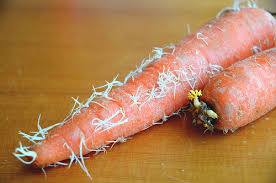6 June 2014
Philemon Buruzi
Local horticultural producers have always indicated that the lack of market access is the major threat to the viability of their businesses. It was widely touted that cheap imports were crowding out the local produce from the best markets. The agricultural authorities recently imposed a ban on the importation on agricultural products in a bid to give local producers a chance. It is fact, that despite this move by policy makers, a good number of our farmers are still not able to access the revered, well paying markets as a result of failing to meet the quality dictates of those particular markets such as hotels, upmarket eateries and big supermarkets. One crop that has quality considerations that are not so obvious is carrots and a lot of producers unknowingly flout them. This article is crafted to enable new carrot growers to pick their way through with relative ease as well as assist the old players to rectify their misdemeanours.
In carrots quality is mainly defined by a specific market but is generally centred on issues to do with the shape, size, colour, succulence, taste and freedom from deformities. The achievement of the right quality requires a combination of good agronomy and an enabling physical environment as enshrined below.
Climatic Conditions
Carrots regardless of the variety or colour generally require cool weather conditions to thrive even though they have been seen to grow in warmer regions as well. Optimal growth is normally achieved under ambient temperatures ranging from 15-220C. Whilst a good number of farmers do not take the temperature issue seriously I would like to point out here and now that if the culture of carrots is attempted and it so happens that the plants are exposed to temperatures below 100C for a prolonged period, one is bound to harvest a crop of long slender, pale roots with a funny taste. Conversely, protracted exposure to temperature upward of 300C results in short, stout and coarse roots with an uncharacteristic strong flavour. These elements are important if you wish to be respected as a supplier to well paying markets.
Soil Characteristics
Carrots are root crops and as such require soils that allow easy displacement as the roots develop. Deep, loose and well drained soils are ideal as carrots do not thrive under waterlogged conditions regardless of the fact that they require constant moisture always. Soil types of choice in this regard would be sand-loams or generally light loamy soils with a pH range of between 6.0 -6.5. Heavy soils are not ideal as they resist the free development of the roots forcing them to assume the undesirable crooked appeal. The ideal soil should not have too much organic matter as this is known to excessively promote foliar growth at the expense of the roots. Excessive organic matter content is also known to cause a raft of deformities such a forking and hairiness. Brackish soils should be avoided at all costs because carrot does not do well under saline conditions. Apart from that, rocky soils will affect the quality of one’s produce by yielding crooked carrots with split roots.

Forked carrots

Hairy carrots
Establishment Methodology
Since carrots are established in-situ there is need to pay particular attention to the preparation of the field. Ploughing depth should be at least 30cm in order to sufficiently loosen the soil for easier air and water percolation. One should make the tilth as fine as possible and also ensure that the field is levelled. Fumigation could be undertaken wherever deemed necessary to avoid the nematode problem. A crumbly moist soil is ideal for the germination of the very small and delicate carrot seed. Make shallow lines on the prepared piece of land and sow the seeds, covering them lightly with soil. Planting depth should be 25mm at most in heavy soils but can be as much as 40mm in light sandy soils to facilitate for easier germination and emergence. It is recommended to slightly increase the planting depth when doing a summer crop to militate against rapid soil surface drying which might impede with the germination. This row planting is deemed better over broadcasting as it makes it easier to carry out other management practices such as weeding later on. Rows should ordinarily be spaced 200-400mm apart, but if you are targeting the baby carrots market then the row spacing should be narrowed down to 100mm. The usual seeding rate for carrots is a 5-10kg seed per hectare and this achieves a plant density of between 150- 160 plants per square meter. In order to support sound development of the roots, remember to thin the crop to allow a 10cm gap in-between the plants. Thinning should commence 30 days after sowing and can be accompanied by hilling up. Failure to thin out results in very thin longish roots and at times multiple roots twisted around each other.
Fertiliser requirements
Organic farmers are encouraged to use well decomposed manure at a rate 3-5t/ha applied two weeks before sowing of seeds. Care should be taken when using compost as it has always been linked with the production of hairy carrots. This is also repeated about 30 days post emergence after thinning and weeding. The manure should always be covered lightly by soil. Inorganic fertiliser can ordinarily be applied at the rate of 120kg/ha nitrogen, 71kg/ha phosphate and 170kg/ha potassium. We have compound fertilisers which meet these requirements on the market. I however should stress that actual requirement for fertiliser application varies widely with soil type and previous usage. As such there is need to do a soil analysis in order to be within the correct range of your soil’s nutrient requirements. Farmers should bear in mind that carrots do not need so much nitrogen and excess application of nitrogen fertiliser results in development of carrots with multiple roots, hairs and a funny taste.
Irrigation
It is important to manage your irrigation in such a manner that soil is not allowed to dry out completely at any particular point during the growth phase. Irrigation should commence immediately after sowing whereby water is applied lightly to initiate the germination process. It is necessary to ensure that the soils are moist at all times between sowing and emergence. Water application should be done once or twice a day depending on the evaporation rate but care should be exercised to avoid excess watering as this often results in short stubby carrots, light in colour with a huge diameter. Deliberate reduction in water application should be done as the crop matures to avoid malformations such as longitudinal splitting. On the other hand severe moisture stress during root development causes cracking and hardening of the roots. Irregular and inconsistent watering can result in forking of the roots.

Longitudinal splitting
Weed control
It is important for a farmer ensure that their field is always free of weeds as this ensures that all the fertiliser and water provided benefits the crop entirely. The moment weeds are allowed to spiral out of control, overall yield and quality is compromised. Weeding should be done early enough to rid the field of any competing plants. It can be effected mechanically, by hand or by way of registered herbicides.
Pests and diseases
Common pests that can affect a crop of carrots are aphids, red spider mites and cutworms. Keen scouting can help one to spot the infestation before it spreads wide. Fortunately all of the problematic pests can be contained by insecticides found on the local market. Diseases that one can expect to grapple with are powdery mildew, bacterial soft rot, Alternaria blight, bacterial blight and root knots nematodes. A good use of fungicides as well as rotation with non-host crops like maize can help control these diseases. It is important in the light of disease control to use disease free certified seed always. (This section on pests and diseases will be dealt with in greater detail in another article).

Carrots affected by root knot nematodes
In as much as the issues discussed in this article are not exhaustive, it remains my humble belief that taking note of them can go a long way in improving the yield quality as well as the quantities. So, go ahead and produce carrots that befit the quality expectations of your customers. Indeed the hotels and supermarkets are waiting for your produce but just ensure that it is of the right QUALITY.
For all questions and comments: philemonburuzi@gmail.com. Responses will be provided within the shortest possible time.
http://www.agriuniverse.co.zw

